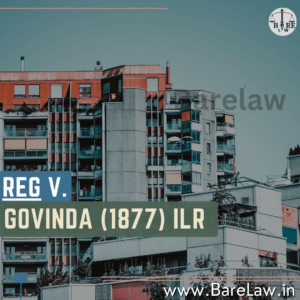Simplifying Your Life & Law | Legal Drafting services
PRIMARY DETAILS OF THE CASE:
Case No
Jurisdiction
Case Filed (in years)
Case Decided on
Judges
:
:
:
:
:
Criminal Appeal No. 90 of 1957.
CRIMINAL APPELLATE JURISDICTION Supreme Court of India
1957
March 11, 1958
Justice Bose
Introduction:
It is a well-known concept that an offense should satisfy the principle of concurrence. In other words, the principle of concurrence means, that a mere act would not amount to offense in a general scenario unless there is an exception mentioned to the same. Thus, one of such examples can be seen through this case brief, where the court stresses the importance of section and interprets the meaning of the same.
Facts of the Case:
The facts of the case are that the accused Mr. Virsa Singh pushed/thrust a spear into the stomach of the deceased person, Mr. Khem Singh. As a result of such an act, the victim died. Post-mortem and further Medical reports noted that the injury caused by the accused was sufficient to cause death in the ordinary course of nature. Sessions Court found the accused for the offense of murder and sentenced him under section 302. The high court reiterated the judgment of the session’s court and upheld his conviction.
Legal Principles/Laws Concerned:
- Section 300 of the Indian Penal Code
Section 300 of IPC deals with a culpable homicide that will amount to murder if the act to cause death was done to cause death or the act is done to cause bodily injury and the offender has the knowledge that such injury will cause death or thirdly, the offender had the intention to cause death and mere bodily injury would suffice as the cause of death during the ordinary course of nature. The section is as follows,
“Except in the cases hereinafter excepted, the culpable homicide will be murder, if the act by which the death is caused is done to cause death, or
Secondly.—If it is done to cause such bodily injury as the offender knows to be likely to cause the death of the person to whom the harm is caused, or—
Thirdly.—If it is done with the intention of causing bodily injury to any person and the bodily injury intended to be inflicted is sufficient in the ordinary course of nature to cause death, or—
Fourthly —If the person committing the act knows that it is so imminently dangerous that it must, in all probability, cause death or such bodily injury as is likely to cause death, and commits such act without any excuse for incurring the risk of causing death or such injury as aforesaid”
Court reasoning:
The Bench quoted section 300 of IPC (thirdly) and insisted the requirements under the section for a person to be charged and penalized for culpable homicide amounting to murder. It further went on to differentiate the essence in section one and subsection third of Section 300. The court opined that both the sections are disjunctive and separate. As per the reasoning of the bench, Section 300 subsection 1 is subjective, which means that it is more aligned towards the offender’s direct intention to cause the death of the victim.
For example, let’s say ‘A’ murdered the victim and was charged under section 300 of IPC. Now, to prove part 1, the prosecution should establish that Accused ‘A’ had intention, that is the prior malicious intent or anger or anything which proves his intention to kill the victim. He doesn’t need to inflict injury, as it is not a primary requirement under this part and that is irrelevant to consider so.
Whereas the court observed that few requirements need to be established to prove section 300 third part. Firstly, it must be found that there was a bodily injury caused by the act of the accused. In other words, they should establish that there was an injury in the heart, stomach, or head, and so on. Once that has been established then the prosecution as per this court should shift to prove the Intention part, which is the most important requirement along with the requirement of bodily injury. Court noted that no one has the license to inflict bodily injury which is sufficient to cause death in the ordinary course of nature. In other words, just because of the lenient fact that the intention of causing the harm should be proved for any offense, the same cannot be taken as the key to commit offenses or inflict bodily often. Court referred to Lord Goddard’s decision in the R v. Steane case, where the chief justice observed that when there is an intention that is specified and charged, then it is of course the duty to prove such intention of the offender. Once these elements are proved, then the examination shifts to the last category, that is, it must be proved that the injury mentioned earlier is sufficient to cause death in the ordinary course of nature. Court noted that this part is purely objective and inferential and has nothing to do with the intention of the accused.
Thus, the court laid down essentials to be proved to effectuate section 300 3rd part. They are,
- There must be bodily injury inflicted by the act of the accused,
- The accused had an intention to cause the death of the victim,
- Such bodily injury inflicted should cause the death of the victim, in the ordinary course of nature.
Conclusion:
Having laid down the three main ingredients that have to be proved by the prosecution for section 300 – third part, it held that it is insufficient to prove that the injury was found to be present and would cause death in the ordinary course of nature. In addition, it is also to be shown that the injury found to be present was the injury that was intended to be inflicted. The court dismissed the appeal made by the accused against his conviction and upheld that his sentence was decided by both session and High courts.
You may also like to read:
-
03 Jul 2021 Case BriefsSakshi vs Union of India
-
18 Aug 2021 Case BriefsI.R. Coelho v State of Tamil Nadu
-
25 Aug 2021 Case BriefsCase brief of K. M. Nanavati v. the State of Maharashtra
-
04 Sep 2021 Case BriefsCase Brief: Reg v. Govinda (1877) ILR Bom 342
-
10 Jul 2021 Know Your LawCulpable Homicide and Murder




